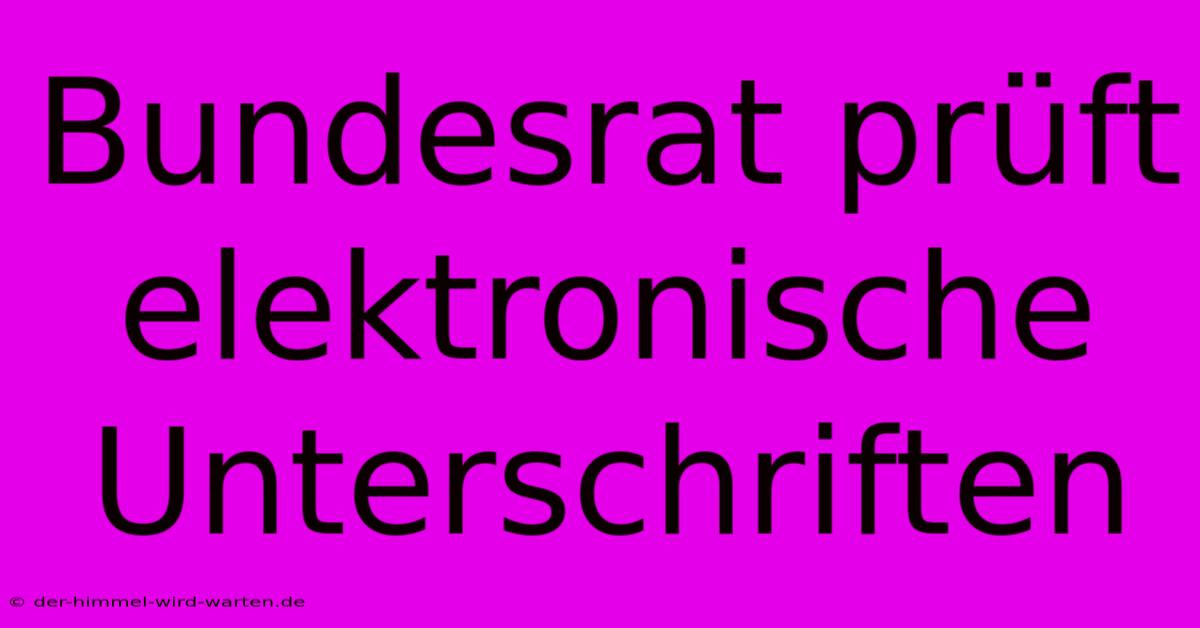Bundesrat Prüft Elektronische Unterschriften

Discover more detailed and exciting information on our website. Click the link below to start your adventure: Visit Best Website Bundesrat Prüft Elektronische Unterschriften. Don't miss out!
Table of Contents
Bundesrat prüft elektronische Unterschriften: Was bedeutet das für dich?
Hey Leute! Let's talk about something kinda geeky but super important: elektronische Unterschriften. The Bundesrat is reviewing them, and that affects all of us, right? I mean, who hasn't wrestled with a digital signature at some point? I sure have! Remember that time I tried to sign a super important contract online for my old freelance gig? Total disaster. The website was clunky, the instructions were in, like, five different languages I didn't understand, and I ended up spending three hours freaking out before I finally figured it out. Ugh.
Die Herausforderungen elektronischer Unterschriften
The whole process felt incredibly complicated. That experience taught me a lot about the importance of user-friendly design when it comes to digital signatures – something the Bundesrat should totally be considering in their review. It's not just about the tech; it's about making things accessible and intuitive for everyone, from your Oma to your tech-savvy nephew.
Benutzerfreundlichkeit ist King!
Think about it: If signing a document online is a headache, people are going to avoid it. And that’s a huge problem, especially as more and more things move online. The Bundesrat needs to ensure that these e-signatures are as easy to use as possible, maybe even easier than a traditional pen-and-paper signature. We're talking clear instructions, straightforward interfaces, and maybe even some helpful video tutorials. You know, stuff that actually works. No more three-hour struggles!
Sicherheit und Datenschutz: Zwei Seiten derselben Medaille
But ease of use isn't everything. Security and data protection are equally crucial, maybe even more crucial. My old freelance contract fiasco also highlighted the security concerns. I was worried the whole time about someone intercepting my signature or my data getting hacked. That stress level? Unacceptable.
Datenschutz muss gewährleistet sein!
The Bundesrat's review needs to address this seriously. We need strong regulations to ensure that elektronische Unterschriften are secure and that our personal data is protected. This means implementing robust security protocols, clear data protection policies, and regular audits to ensure everything is running smoothly. Think encryption, multi-factor authentication – the works! The goal is to create a system that's both user-friendly and secure.
Was bedeutet das für die Zukunft?
So, what's the bottom line? The Bundesrat's review of elektronische Unterschriften is a big deal. It has the potential to improve how we interact with digital documents. But it needs to get the balance right. We need systems that are easy to use, secure, and protect our privacy. If they nail it, we’ll see smoother online transactions, increased efficiency, and a more streamlined digital experience. Fail, and we’re back to wrestling with clunky websites and worrying about security breaches.
The future of digital signing in Germany rests on their shoulders. It's a huge responsibility, and I hope they get it right this time. I, for one, am looking forward to a future where signing a document online is as easy as breathing. And maybe, just maybe, less stressful than my freelance contract debacle.
Keywords:
Elektronische Unterschrift, Bundesrat, digitale Signatur, Datenschutz, Sicherheit, Benutzerfreundlichkeit, Online-Vertrag, eSignature, digitaler Workflow, gesetzliche Regelung, Deutschland.

Thank you for visiting our website wich cover about Bundesrat Prüft Elektronische Unterschriften. We hope the information provided has been useful to you. Feel free to contact us if you have any questions or need further assistance. See you next time and dont miss to bookmark.
Featured Posts
-
Pochers Coup Amira Verkauft Marke
Nov 21, 2024
-
Zuerich Spi Kurs Steigt Am Starken Tag
Nov 21, 2024
-
Seniorin Um 45 000 Euro Betrogen Polizei Warnt
Nov 21, 2024
-
Ursula Haverbeck Holocaustleugnerin Gestorben
Nov 21, 2024
-
Verschoben Heise Microsoft Flight Spezial
Nov 21, 2024
